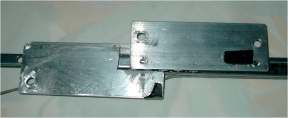
This sliding bar was in my mind for a while. During the 2002 autumn, I shot almost one roll of stereoscopic pairs in Yosemite National Park, and it took time to adjust the cameras each times I had to change the base. So the next weeks, I prepared a sliding bar. |
|
In a Do-It-Yourself shop, it is easy to get a sliding bar which are sold by pairs for drawers. Choose the ones with balls inside and check the bar is well stiff. When sliding, if it seems too loose, it is possible to tighten it a bit by pressing it in a vice. |
The sliding bar is 16.5 x 10 x 240mm. What you have to do is to prepare two platforms, one for each camera. Both are in aluminum plate, 2mm thick. The first platform is a 110x40mm plate fixed straight on top of the inside bar, at one end with two Ø2mm bolts.
Then holes Ø6.5mm are drilled to mount the cameras on the platforms. At the end, two plastic stripes (black on the picture) are glued on the platform, and are put in such a way that the cameras are stopped on it when pointing on the same target. |
|
The second platform is made of two plates. The bottom one is 30x110mm fixed underneath, on the main bar with Ø2mm bolts. On each side, there are two 110mm long aluminum U shapes 10x5x1mm which are fastened to the bottom and top plate with Ø2mm rivets. The rivets are grounded flush. The top plate is 110x40mm, but in one corner, a space 20x35mm is cut, so that the first platform is running in and get the cameras closer as minimum distance.
|



